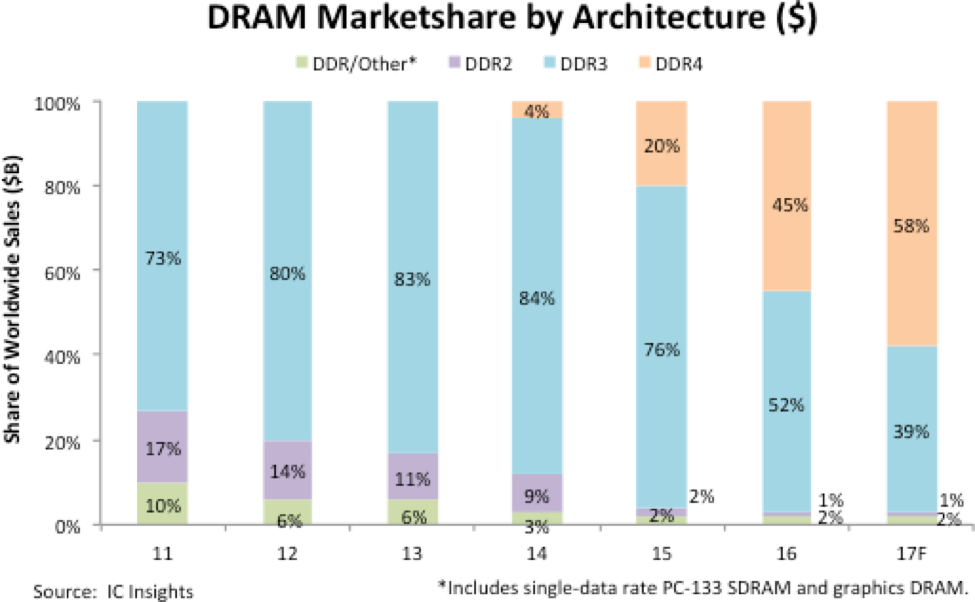Earlier this month, IC Insights confirmed that DDR4 DRAM gained significant market share in 2016, representing 45% of total DRAM sales. DDR3 DRAM – including low-power versions used in tablets, smartphone and notebook PCs – accounted for 84% of total DRAM sales in 2014 and 76% in 2015.

By 2016, DDR4 price premiums had evaporated, with prices falling to nearly the same ASP as DDR3 DRAMs. Concurrently, DDR4 spread into more data center servers, mainframes and high-end PCs, accounting for approximately 45% of total DRAM sales versus 20% in 2015. This year (2017), DDR4 is expected to move into more notebook PCs, high-end tablets and smartphones – while maintaining a 58% share of DRAM sales.
“A growing number of microprocessors, like Intel’s newest 14nm x86 Core processors, now contain DDR4 controllers and interfaces,” IC Insights analysts explained. “As a result, IC Insights expects DDR4 to become the dominant DRAM generation in 2017 with 58% market share versus 39% for DDR3.”
As IC Insights analysts note, the DDR4 standard includes a number of features that are expected to speed up memory operations and increase SDRAM storage in servers, notebook and desktop PCs, tablet computers, along with a wide range of consumer electronics.
“The DDR4 standard supports stacked memory chips with up to eight devices presenting a single signal load to memory controllers,” the IC Insights analysts stated. “Compared to DDR3, DDR4 can potentially double the module density, double the speed and lower power consumption up to 20%, thereby extending battery life in future 64-bit tablets and smartphones.”

Looking beyond DDR4, JEDEC recently confirmed that its upcoming DDR5 memory standard will offer improved performance with greater power efficiency as compared to previous generation DRAM technologies.
“DDR5 will provide double the bandwidth and density over DDR4, along with delivering improved channel efficiency,” JEDEC stated in March 2017. “These enhancements, combined with a more user-friendly interface for server and client platforms, will enable high performance and improved power management in a wide variety of applications.”
According to PC World’s Agam Shah, it’s not certain when memory makers will launch DDR5 products.
“Like DDR4, DDR5 may first make it into servers and high-end gaming PCs and then to laptops. A low-power form of DDR5 could make it available for mobile devices,” Shah explained. “Samsung’s latest Galaxy S8 smartphones have LPDDR4 memory. Chip and motherboard makers will also have to build in support for the new DDR5 memory and that process could take longer than a year after the specification is released.”
In addition, says Shah, applications such as databases are moving to in-memory processing.
“Companies like Dell and Hewlett Packard Enterprise are doubling memory capacity in servers at fast rates to handle those applications,” he added.
